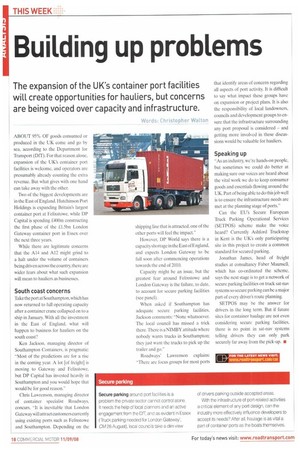Building up problems
Page 18

If you've noticed an error in this article please click here to report it so we can fix it.
The expansion of the UK's container port facilities will create opportunities for hauliers, but concerns are being voiced over capacity and infrastructure.
Words: Christopher Walton ABOUT 95% OF goods consumed or produced in the UK come and go by sea, according to the Department for Transport (DfT). For that reason alone, expansion of the UK's container port facilities is welcome, and operators are presumably already counting the extra revenue. But what gives with one hand can take away with the other.
Two of the biggest developments are in the East of England. Hutchinson Port Holdings is expanding Britain's largest container port at Felixstowe, while DP Capital is spending £.400m constructing the first phase of the E1.5bn London Gateway container port in Essex over the next three years.
While there are legitimate concerns that the A14 and Al2 might grind to a halt under the volume of containers being driven across the country, there are wider fears about what such expansion will mean to hauliers as businesses.
South coast concerns
Take the port at Southampton, which has now returned to full operating capacity after a container crane collapsed on to a ship in January With all the investment in the East of England, what will happen to business for hauliers on the south coast?
Ken Jackson, managing director of Southampton Containers, is pragmatic: "Most of the predictions are for a rise in the coming year. A lot [of freight] is moving to Gateway and Felixstowe. but DP Capital has invested heavily in Southampton and you would hope that would be for good reason."
Chris Lawrenson, managing director of container specialist Roadways, concurs. "It is inevitable that London Gateway will attract customers currently using existing ports such as Felixstowe and Southampton. Depending on the shipping line that is attracted, one of the other ports will feel the impact."
However, DP World says there is a capacity shortage in the East of England, and expects London Gateway to be full soon after commencing operations towards the end of 2010.
Capacity might be an issue, hut the greatest fear around Felixstowe and London Gateway is the failure, to date, to account for secure parking facilities (see panel).
When asked if Southampton has adequate secure parking facilities, Jackson comments: "None whatsoever. The local council has missed a trick there. There is a NIMBY attitude where nobody wants trucks in Southampton: they just want the trucks to pick up the trailer and go."
Roadways' Lawrenson explains: "There are focus groups for most ports that identify areas of concern regarding all aspects of port activity. It is difficult to say what impact these groups have on expansion or project plans. It is also the responsibility of local landowners, councils and development groups to ensure that the infrastructure surrounding any port proposal is considered — and getting more involved in these discussions would be valuable for hauliers.
Speaking up
"As an industry, we're hands-on people, but sometimes we could do better at making sure our voices are heard about the vital work we do to keep consumer goods and essentials flowing around the UK. Part of being able to do this job well is to ensure the infrastructure needs are met at the planning stage of ports."
Can the EU's Secure European Truck Parking Operational Services (SETPOS) scheme make the voice heard? Currently Ashford Truckstop in Kent is the UK's only participating site in this project to create a common standard for secured parking.
Jonathan James, head of freight studies at consultancy Faber Maunsell, which has co-ordinated the scheme, says the next stage is to get a network of secure parking facilities on truck sat-nay systems so secure parking can be a major part of every driver's route planning.
SETPOS may be the answer for drivers in the long term. But if future sites for container haulage are not even considering secure parking facilities, there is no point in sat-nay systems telling drivers they can only park securely far away from the pick-up. •
Li FOR THE LATEST NEWS VISIT:












































































































































































